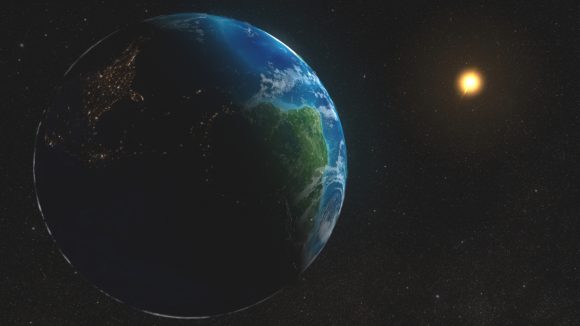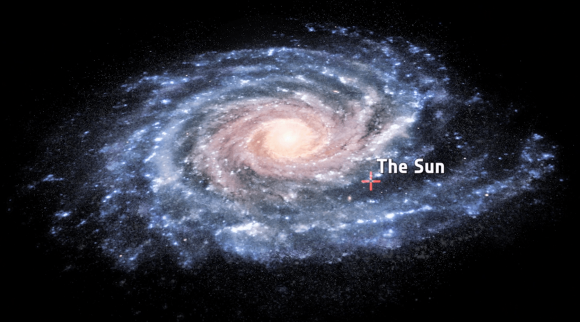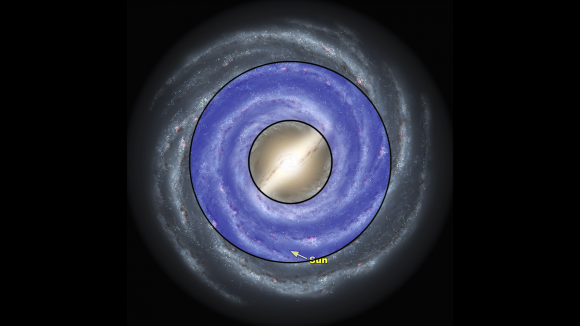I’ve got to say, you are one of the luckiest people I’ve ever met.
For starters, you are the descendant of an incomprehensible number of lifeforms who were successful, and survived long enough to find a partner, procreate, and have an offspring. Billions of years, and you are the result of an unbroken chain of success, surviving through global catastrophe after catastrophe. Nice going.
Not only that, but your lineage happened to be born on a planet, which was in just the right location around just the right kind of star. Not too hot, not too cold, just the right temperature where liquid water, and whatever else was necessary for life to get going. Again, I like your lucky streak.

In fact, you happened to be born into a Universe that has the right physical constants, like the force of gravity or the binding force of atoms, so that stars, planets and even the chemistry of life could happen at all.
But there’s another lottery you won, and you probably didn’t even know about it. You happened to be born on an unassuming, mostly harmless planet orbiting a G-type main sequence star in the habitable zone of the Milky Way.
Wait a second, even galaxies have habitable zones? Yep, and you’re in it right now.
The Milky Way is a big place, measuring up to 180,000 light years across. It contains 100 to 400 billion stars spread across this enormous volume.
We’re located about 27,000 light years away from the center of the Milky Way, and tens of thousands of light-years away from the outer rim.

The Milky Way has some really uninhabitable zones. Down near the center of the galaxy, the density of stars is much greater. And these stars are blasting out a combined radiation that would make it much more unlikely for life to evolve.
Radiation is bad for life. But it gets worse. There’s a huge cloud of comets around the Sun known as the Oort Cloud. Some of the greatest catastrophes in history happened when these comets were kicked into a collision course with the Earth by a passing star. Closer to the galactic core, these disruptions would happen much more often.
There’s another dangerous place you don’t want to be: the galaxy’s spiral arms. These are regions of increased density in the galaxy, where star formation is much more common. And newly forming stars blast out dangerous radiation.
Fortunately, we’re far away from the spiral arms, and we orbit the center of the Milky Way in a nice circular orbit, which means we don’t cross these spiral arms very often.
We stay nice and far away from the dangerous parts of the Milky Way, however, we’re still close enough to the action that our Solar System gathered the elements we needed for life.
The first stars in the Universe only had hydrogen, helium and a few other trace elements left over from the Big Bang. But when the largest stars detonated as supernovae, they seeded the surrounding regions with heavier elements like oxygen, carbon, even iron and gold.

Our solar nebula was seeded with the heavy elements from many generations of stars, giving us all the raw materials to help set evolution in motion.
If the Solar System was further out, we probably wouldn’t have gotten enough of those heavier elements. So, thanks multiple generations of dead stars.
According to astrobiologists the galactic habitable zone probably starts just outside the galactic bulge – about 13,000 light-years from the center, and ends about halfway out in the disk, 33,000 light-years from the center.
Remember, we’re 27,000 light-years from the center, so just inside that outer edge. Phew.

Of course, not all astronomers believe in this Rare Earth hypothesis. In fact, just as we’re finding life on Earth wherever we find water, they believe that life is more robust and resilient. It could still survive and even thrive with more radiation, and less heavier elements.
Furthermore, we’re learning that solar systems might be able to migrate a significant distance from where they formed. Stars that started closer in where there were plenty of heavier elements might have drifted outward to the safer, calmer galactic suburbs, giving life a better chance at getting a foothold.
As always, we’ll need more data, more research to get an answer to this question.
Just when you thought you were already lucky, it turns out you were super duper extra lucky. Right Universe, right lineage, right solar system, right location in the Milky Way. You already won the greatest lottery in existence.


About time someone touched on this. Every time I hear the Drake equation, I think “how do we know all the planets in the entire galaxy have the same chance of being inhabited?”. In other words, Drake uses a number to represent what we think is the number of planets in the galaxy. But if 1/3 are in the center zone of “no chance in hell”, why are they being counted. Ok, so enough about that. Any news on when we’re leaving our gas cloud (just piggy-backing on the ‘can’t live in the spiral arms’ thing)?
How do we know all the planets have the same chance of being inhabited? The simple answer is we don’t know. If we stick in our best guesses, which are usually based on the life we know, then we may miss looking for something totally unexpected, but we can’t do the statistics for things we don’t know, so we stick with what we do know.
With all the uncertainties, the Drake fraction has huge error bars. It is perhaps more helpful to consider how the fraction changes when we add something we do know. If we find planets around dwarf stars with the possibility of liquid water, then this adds a lot of potential planets around a lot of very long-lived stars. If the star’s radiation might sterilize the surface of the planet, then the fraction goes back again. But we might have sub-surface life, so up it goes. The fraction has mostly been going up since Drake’s paper in the sixties as we learn new stuff.
A lot of real science is like this. We have guesses we aren’t happy with, and we poke about, trying to find which bits are sound, and which bits can be improved. You are very lucky if you can actually be there when a significant bit drops into place.
Surely the pockets between the spiral arms at any distance from the galactic core can be part of the Milky Way’s goldielocks zone, even if the star system is catapulted out into the far reaches.
Sounds to me like the perfect conditions were created for life to be possible. At what point does it stop looking “lucky?” This doesn’t seem random to me. It seems intentional.
Respectfully, I really don’t see where you get intentionality from any of this. Or luck, for that matter. The conditions for life are hardly perfect, as the article even points out the countless stellar threats that exist all around us. We’re fortunate to live in a less hostile zone (which was the point of the article), but simple probability imputes a higher likelihood of finding life in areas that are more hospitable to life.
Life finds a way. When all the ingredients are together in the right niche, and safe from disruptions, they start the long difficult journey to awareness.
It would be surprising, wouldn’t it, to find ourselves in a universe, or part of a universe, which was not suitable for life..?
Habitable zone? I think we should include our entire space-time? For instance, how do we know that the stars themselves aren’t ‘alive’ somehow in an infinitely larger continuum? Ever thought of galaxies as microbes? Or the atoms in microbes as galaxies? As a pantheist.. we believe the whole shooting match is alive and that infinity is way big in dimensions we do not or can not even begin to perceive, much less imagine, with our evolving senses…
I guess if you use your own definition of “alive” (read: you are doing this) then yes, it’s fine to think so. If you’re implying that there’s some sort of universal consciousness, then we’ll just have to agree to disagree, based on the paucity of evidence (read: there is none). However, if believing in this new age stuff brings you fulfillment and happiness, cheers.
It’s all a matter of perspective.. if you see what I mean.
http://plato.stanford.edu/entries/pantheism/
I certainly feel sorry for the people born in the center of the galaxy. What rotten luck.
I understand why the the central part of the galaxy may not be habitable, but why is the outer part not considered habitable?
Is there any evidence that the outer fringe of the galaxy have less metals than in the sun’s location ?
Extra Terrestrials create the star systems and planets similar to how Humans create housing developments.
Extra Terrestrials place the humans on Earth and live among them as Humanoid Extra Terrestrials.
Humanoid Extra Terrestrials have lived here the whole time.
Millions of the most famous, powerful, wealthy etc.. people living on the planet are Humanoid Extra Terrestrials and most Earthlings aren’t even aware this is a possibility.
Notice how this is not even given any consideration by all the so called experts of the “ET” search.
The even funnier part is when all the Earthlings wake up and realize those vehicles transiting our star system aren’t even FLYING and we call them Unidentified Flying Objects.
The Earthlings are in for a rude awakening one day.
God created earth and created it to be habitable for man. His word does not mention any other life anywhere but here. There are far to many things that had to be just perfect for life to exist here, distance from sun and moon, rotation, axis, it goes on and on. Far to many to be explained by chance, it had to be designed. And to be designed means there must be a designer. There is just no reason to believe their is “intelligent” life out there, other than the odds that are always talked about. God created this vast universe for our enjoyment, and we are definitely doing that.
Nah, you just don’t understand how probability works.
Yes, that is just such a hard concept to grasp.
From a different perspective, our existence given all the circumstances is inevitable. Our existence without that unbroken chain would be almost unfathomably luckier, and yet in principle, perhaps not impossible.
Based on this video maybe a good topic to discuss would be the Anthropic principle (if you haven’t done this topic already).
Some more thoughts about habitability in our galaxy can be found at this Scientific American blog: http://blogs.scientificamerican.com/guest-blog/do-dolphins-dream-of-space-travel/?utm_source=feedburner&utm_medium=feed&utm_campaign=Feed%3A+sciam%2Fspace+%28Topic%3A+Space%29
“You are one of the LUCKIEST people I’ve ever met. …. you were SUPER DUPER EXTRA LUCKY. ….. You won the GREATEST LOTTERY in existence.”
Yup. That’s 1 interpretation of the data, but there are other possible interpretations that make even better sense IMHO. Like this 1 from the world’s all time best seller:
“For thus says the LORD, who created the heavens (he is God!), who formed the earth and made it (HE ESTABLISHED IT; HE DID NOT CREATE IT EMPTY, HE FORMED IT TO BE INHABITED!): “I am the LORD, and there is no other.” Is. 45:18
Sounds pretty accurate to me!
“Of course, not all astronomers BELIEVE in this Rare Earth hypothesis.”
“As always, we’ll need more research to get an answer.”
Right. NO AMOUNT OF EVIDENCE – no matter what it is – IS EVER SUFFICIENT to challenge the materialist paradigm! It is absolutely unfalsifiable.
No matter what the evidence points to, no other hypothesis is allowed. They are more concerned with protecting “science”(meaning Materialism) than letting the facts speak for themselves.
I prefer to believe in a sufficient Cause and I do not see CHANCE (Stuff Just Happens!) as a very scientific belief/conclusion!
But that hypothesis is ruled out before even looking at the data! The more we learn, the more unique and rare earth becomes – but those who prefer to believe in the god of CHANCE can always hide their faith in the “we need more research” ploy.
And they call that SCIENCE! Go figure!
Extending Galactic Habitable Zone Modeling to Include the Emergence of Intelligent Life.
“Even under the assumption that long time durations are required between sterilizations to allow for the emergence of intelligence, our model suggests that the inner Galaxy provides the greatest number of opportunities for intelligence to arise. This is due to the substantially higher number density of habitable planets in this region, which outweighs the effects of a higher supernova rate in the region. Our model also shows that ?I is increasing with time. Intelligent life emerged at approximately the present time at Earth’s galactocentric radius, but a similar level of evolutionary opportunity was available in the inner Galaxy more than 2?Gyr ago. Our findings suggest that the inner Galaxy should logically be a prime target region for searches for extraterrestrial intelligence and that any civilizations that may have emerged there are potentially much older than our own.”
http://www.mit.edu/~gowanloc/publications/submitted/MorrisonGowanlock_GHZ_Astrobiology_submitted.pdf,
I was thinking that any civilization that had progressed far enough to leave their stellar system would leave some type of marker on their sun after it became a white dwarf or neutron star. Would other civilizations create a monument to their dead sun, like we create monuments to our heroes. Look at all our ancient civilizations that worshiped the sun, I could imagine the sentimental anguish we would feel when our sun becomes a white dwarf. So maybe we should look for something in these ghost stars that may indicate the birth of a great civilization came from this now dead star!
Could the huge variety of Planetary Nebula shapes be because of extraterrestrial civilizations creating a form of art from their dying star? Think about what makes humans so different from the other species on this planet – that one huge differences is to are ability to create art. I’m not just talking about paintings but in almost every thing we create with our imaginations. Maybe this is what we should be looking for when it comes to alien races and what better then the huge planetary nebula’s that can be seen from huge distances and strange variety of shapes and colors. We can even see them in other galaxies beside our own. It would be interesting to look at much younger galaxies and see if they have such a huge variety of shapes.
https://en.wikipedia.org/wiki/Planetary_nebula
https://en.wikipedia.org/wiki/List_of_planetary_nebulae
http://stars.astro.illinois.edu/sow/pn.html
https://www.britannica.com/topic/planetary-nebula
Mystery Alignment of Dying Stars Puzzles Scientists.
http://www.space.com/22638-planetary-nebula-mystery-hubble-telescope.html
These “cosmic butterflies” — actually a certain type of planetary nebula — all have their own formation histories, and they don’t interact with each other. But something is apparently making them dance in step
They found most of these objects to be scattered more or less randomly across the sky, but one type — the bipolar nebulae, which have distinctive butterfly or hourglass shapes that are thought to result when jets blast material away from a dying star perpendicular to its orbit — showed a surprising alignment.
“The alignment we’re seeing for these bipolar nebulae indicates something bizarre about star systems within the central bulge,”Rees said. “For them to line up in the way we see, the star systems that formed these nebulae would have to be rotating perpendicular to the interstellar clouds from which they formed, which is very strange.”
http://www.spacetelescope.org/images/heic1316a/
Makes you kind of wonder!
Astronomers in South Africa discover mysterious alignment of black holes
http://phys.org/news/2016-04-astronomers-south-africa-mysterious-alignment.html
HUBBLE AND NTT CAPTURE STRANGE ALIGNMENT OF PLANETARY NEBULAE
Article Updated: 23 Dec , 2015
by Tammy Plotner
http://www.universetoday.com/104491/hubble-and-ntt-capture-strange-alignment-of-planetary-nebulae/
Kardashev scale of energy usage. This would make more sense, to use natures natural energy to form something that is not natural (ALIGNMENT OF PLANETARY NEBULAE) to signal there existence, this is more along the line of the Taoist philosophy. Eating up a whole galaxy to produce energy does not sound very intelligent, I think it is just mirroring mans stupidity towards nature. We need to look for more subtle signs of advanced intelligent extraterrestrial civilizations!
http://www.universetoday.com/129735/will-type-iii-civilization/
Kardashev Type II civilizations in the older central bulge of our galaxy.
http://futurism.com/the-kardashev-scale-type-i-ii-iii-iv-v-civilization/